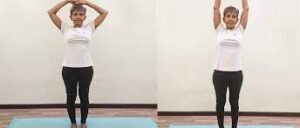What is Tadasana (Palm Tree Posture) ? – Steps, Poses and Benefits
What is Tadasana (Palm Tree Posture) ?
- Tada in Sanskrit means ‘Palm tree’. This is called Tadasana because in it the body imitates a ‘Palm tree’. This tree is known for its height and also for being vertically straight. Hence, it has been named tadasana.
Let us perform Tadasana by following the steps given below:
- Starting position: Stand erect, legs together, hands by the side of the thighs. Keep the back straight and gaze in front.
1. Stretch the arms upward, over the head and parallel with each other, with the palms facing each other.
2. Slowly raise the heels and stand on toes. Raise heels as much as you can. Stretch body up as much as possible. Stay for a few seconds in this final position.
Releasing position:
3. While returning to the original position, bring the heels on the floor first.
4. Slowly bring down the hands by the side of the thighs and relax.

Remember the following points:
| Do’s | Don’ts |
| • The inner arms should touch the respective ears and hands parallel to each other. • Stretch the arms and fingers fully. • Keep the head, neck and the body in one line. |
• Do not bend forward or backward. |
Tadasana (Palm Tree Posture) Benefits :-
• It gives vertical stretch to whole body muscles.
• It strengthens thighs, knees and ankles.
• It helps in improving height of growing children.
• It helps to remove laziness and lethargy.
Tadasana (Palm Tree Posture) Limitations :-
• Those having complaints of reeling sensation should not practise it.
• Avoid performing this asana if knee joints and ankle joints are having pain and stiffness.
Yoga Latest Post :- Click Here
TOP YOGA MCQs Questions and Answers
1. Which is the Sanskrit root (verb form) for the etymological derivation of the word “Yoga”?
(A) Yug
(B) Yuge
(C) Yuj
(D) Yuje
Click to show/hide
2. Who was the Yoga Guru of Swami Kuvalayananda?
(A) Pattabhi Jois
(B) T. Krishnamacharya
(C) Madhav Das
(D) Yogendra
Click to show/hide
3. Which of the following practice leads to immortality, according to Ishavasyopanishad?
(A) Vairagya
(B) Viveka
(C) Vidya
(D) Vishaya
Click to show/hide
4. Definition of Yoga according to Kathopanishad is
(A) Control on mind
(B) Control on sense organs, mind and intellect
(C) Control on sense organs and intellect
(D) Control on body and mind
Click to show/hide
5. How many types of Kundalini by nature are described in Siddha Siddhant Paddhati?
(A) 02
(B) 03
(C) 04
(D) 06
Click to show/hide
6. Which Upanishad described the ‘Shandilya Vidya’?
(A) Kathopanishad
(B) Brihadaranyakopanishad
(C) Aitareyopanishad
(D) Chhandogyopanishad
Click to show/hide
7. Which of the following are the types of Pranayama, according to Patanjala Yoga Sutra?
I. Stambhavritti Pranayama
II. Sahita Pranayama
III. Bahyabhyantara Vishayakshepi Pranayana
IV. Kevali Pranayama
Use the codes given below for correct answer:
(A) I and II are correct.
(B) II and III are correct.
(C) I and III are correct.
(D) II and IV are correct.
Click to show/hide
8. Given below are two statements, labelled as Assertion (A), and a Reason (R). Indicate your answer from the alternatives below:
Assertion (A): Pashchimōttanasana is contraindicated in sciatica.
Reason (R): Pashchimōttanasana is a type of forward bending asana.
All types of forward bending asanas should be contraindicated in sciatica. In the context of above two statements, which one of the following is correct?
(A) Both (A) and (R) are true and (R) is the correct explanation of (A).
(B) Both (A) and (R) are true, but (R) is not the correct explanation of (A).
(C) (A) is true, but (R) is false.
(D) (A) is false, but (R) is true.
Click to show/hide
9. In which of the following text ‘Bhujangikaran’ Pranayama is described?
(A) Yoga Vashishtha
(B) Shiva Samhita
(C) Hatha Ratnavali
(D) Siddha Siddhanta Paddhati
Click to show/hide
10. What do you understand by the term ‘Adhi’?
(A) Physical disorders originated in Annamaya Kosha.
(B) Mental/Emotional disorders originated in Manomaya Kosha.
(C) Mental/Emotional disorders originated in Annamaya Kosha.
(D) Physical disorders originated in Manomaya Kosha.
Click to show/hide
11. Which day is celebrated as ‘International Day of Yoga’?
(A) June 20
(B) June 21
(C) June 22
(D) June 23
Answer ⇒ ????
